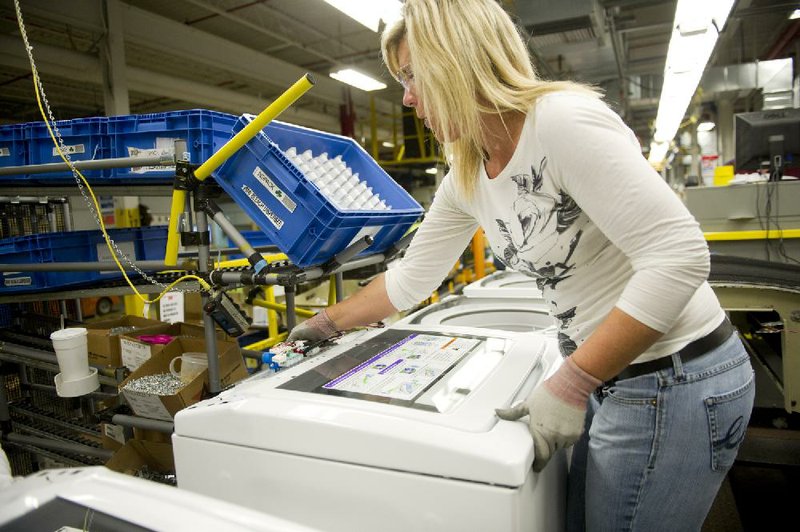NEW YORK — Appliance maker Whirlpool Corp. plans to cut 5,000 jobs, about 10 percent of its work force in North America and Europe, as it faces soft demand and higher costs for materials.
Whirlpool job reductions include 1,200 salaried positions and the closing of the company’s Fort Smith plant, which was announced Thursday.
The Fort Smith plant shutdown, expected in mid-2012, will affect 884 hourly workers and 90 salaried employees. An additional 800 workers were on layoff from the factory and on a recall list.
Whirlpool will also relocate dishwasher production from Neunkirchen, Germany, to Poland in January.
The company expects the moves will save $400 million by the end of 2013. They’ll cost $500 million in restructuring costs, however, which will be recorded over the next three years, including a $105 million charge in the fourth quarter, a $280 million charge in 2012 and a $115 million charge in 2013.
Benton Harbor, Mich.-based Whirlpool’s third quarter net income more than doubled to $177 million, or $2.27 per share, from $79 million, or $1.02 per share. Adjusted earnings of $2.35 per share fell short of analyst expectations for $2.73 per share.
Revenue rose 2 percent to $4.63 billion, short of expectations of $4.74 billion.
“Our results were negatively impacted by recessionary demand levels in developed countries, a slowdown in emerging markets and high levels of inflation in material costs,” Chief Executive Officer Jeff Fettig said.
Whirlpool’s stock fell $8.67, or 14.34 percent, to $51.80 in trading on the New York Stock Exchange. Shares have traded as low as $47.35 and as high as $92.28 over the past year.
“They are on fragile ground financially, and they’ve clearly got to do something to try to lower their cost structure to operate in this really tough consumer environment,” Jeffrey Sprague, an analyst for Vertical Research Partners in New York, said in an interview. Sprague recommends selling Whirlpool shares.
The company said unit shipments fell in all regions except Asia, where they rose 4 percent.
In North America, revenue fell 2 percent to $2.4 billion, and in Latin America, revenue rose 8 percent to $1.2 billion.
The world’s biggest appliance maker also on Friday cut its 2011 earnings outlook drastically and reported third-quarter results that missed expectations, hurt by higher costs and a slowdown in emerging markets. Shares fell 12 percent in midday trading.
The company, whose brands include Maytag and Kitchen-Aid, has, like other appliance makers, been squeezed by soft U.S. demand since the recession and rising costs for materials such as steel and copper. Because of its size, Whirlpool’s performance provides a window on the economy because it indicates whether consumers are comfortable spending on big-ticket items.
Whirlpool has raised prices to combat higher costs, but demand for items such as refrigerators and washing machines remains tight. Whirlpool is also facing discount pressure from competitors.
“Consumers are trading down to lower-price points, housing is still dead, and the consumer is still stressed,” Sprague said, adding that reduced demand is affecting a range of big-ticket appliances, from air conditioners to fridges. “That has had an adverse effect.”
To offset slowing North American sales, Whirlpool has turned to emerging markets. But the company said Friday that sales have slowed there, too. The company revised its demand forecast globally.
It now expects demand to decline 3 percent to 5 percent in North America in 2011, down from a 1 percent to 2 percent prior decline forecast.
It expects flat demand in Europe, the Middle East and Africa, from prior expectations of a 1 percent to 2 percent rise in demand.
In Latin America, it now expects demand to be flat to up 5 percent, from prior expectations of a 5 percent to 10 percent increase. And in Asia it expects demand to rise 2 percent to 4 percent from earlier expectations of a 4 percent to 6 percent increase.
Steep costs and the dour global economy are affecting the entire appliance industry.
Whirlpool followed European rival Electrolux AB with a more muted outlook for the year.
The Swedish company said Friday that it will deepen cost cuts after lowering a forecast for growth in Europe and North America this year.
Whirlpool now expects 2011 net income will be $4.75 to $5.25 per share. Its prior guidance was that net income would be at the low end of a range between $7.25 and $8.25 per share.
Separately, Whirlpool has complained to authorities that some companies, including Samsung Electronics and LG Electronics, have been selling appliances at less than fair value in the U.S., a practice known as “dumping.” Whirlpool said the Commerce Department issued a preliminary determination that the companies are violating international trade laws. The investigation is ongoing.
Information for this article was contributed by Mae Anderson of The Associated Press and by Matt Townsend and Benedikt Kammel of Bloomberg News.
Business, Pages 33 on 10/29/2011
